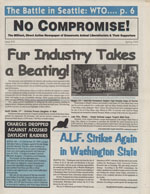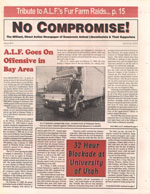» Next Entries
The Archives
-
No Compromise, Periodicals
No Compromise #15-17
09.01.12 | PermalinkNo Compromise #15,16, 17 (2000-2001, Santa Cruz, CA.)
I want to preface this post with this: The turn of the century was an epic time to be alive and fighting! Between the WTO riots, a huge upsurge in ALF attacks on the West Coast, some inspiring support of grand jury resisters, and the migration of the SHAC campaign to the United States, there were also thousands upon thousands of other actions across the planet. It was hard to keep up with all of the news because it seemed that people everywhere had finally taken enough and were beginning a counter strike for non-humans, wilderness, and human freedom. Luckily, No Compromise kept track of most of the action, and produced three excellent issues during this incredible year of revolt. Beyond the coverage of the latest direct actions, attention was also paid to our past successes and failures- and all animal activists would do well to read issue #16’s “Blast From The Past” article about lab raids in the 1980s.
…
-
One-off publications
North American Earth Liberation Front Press Office Subcommittee on Eco-Terrorism
05.22.12 | PermalinkNorth American Earth Liberation Front Press Office Subcommittee on Eco-Terrorism (2002, Portland, OR)
One of the most frequently repeated myths about direct action is that is so damaging to public opinion that if people didn’t already do it, the government would in order to criminalize movements. If this were true it certainly seems that the system would spend less time trying to prevent radical action by silencing it’s proponents and more time harassing the Sierra Club. The truth is that nothing scares corporations and their paid-in-full politician pets like a well organized group with a willingness to fight and the ability to reach the public with their ideas.
In the late 1990s environmental sabotage was happening all across the world, but was particularly frequent in the northwest of the United States. At the forefront of these actions was the Earth Liberation Front, an anonymous, underground group, who utilized above ground spokespeople to reach the public. Their primary conduit for media relations was an activist from Portland named Craig Rosebraugh and his organization, the North American ELF Press Office. For his role in publicizing the motivations and rhetoric of the ELF he had his arm broken by the police, his home raided by Joint Terrorism Task Forces, his break cables cut, was repeatedly subpoenaed to grand juries, and eventually was called to testify before a congressional sub-committee who hoped to imprison him on contempt charges. The so-called “Eco-Terror committee” surely hoped that Craig would be an easy target, but that didn’t exactly work out for them. Snarky, educated, and angry, Craig’s testimony ran the gamut from stonewalling, to educational, to hilarious. For example, while running the Press Office with his friend Leslie James Pickering, Craig owned a bakery. When asked how the press office was funded, Rosebraugh simply replied “muffins.” When asked who had asked him to become the ELF press officer and how he was contacted, Craig responded, “Jesus Christ. It was a spiritual sort of thing.”
Jokes aside, a congressional subpoena represented a shift in the way environmental sabotage was being treated by the system, and publicizing that fact fell to Leslie James Pickering. In order to spread the word about the hearings, the NAELFPO sold a DIY booklet containing all of the testimony presented by both sides at the hearing and the subsequent written questions sent to Craig by the subcommittee. In a recent conversation with Conflict Gypsy about the booklet, Pickering had this to say:
“I can’t say for sure, how many of these were printed, but it was definitely less than 500. I had a little production line going, with people wearing gloves and hats, only half-jokingly, recently having learned about the WUO and Prairie Fire. The subcommittee was in February of 2002 and I left Portland in June of 2002. These booklets were produced somewhere in between there…probably March or April, because I utilized some machinery they had at college before the semester let out and because this was actually in peoples’ hands before it was easily found online. They were distributed through the ELF Press Office, which means that people could send us $10 and get a copy mailed, or get one at one of our event tables. A good chunk of them also went to AK distro, but we never saw a cent from those, which is another story. One of the more interesting aspects were the complaints from anonymous anarchists about it costing too much. This was when the PO was being bombarded with anonymous comments which were critical from many angles. I often think of how much work went into this and how cheap these people were, assuming for a moment that they weren’t all feds. If we didn’t have the old magnet scam going [where large magnets would be used to reset the copy keys at Kinkos – ed] we would probably have lost money at $10, because it was a pretty thick booklet.”

-
No Compromise, Periodicals
No Compromise #12-14
05.15.12 | PermalinkNo Compromise #12-14 (1999, Old Bridge, NJ and Santa Cruz, CA)
If I had to create a list of my favorite years in animal and earth liberation history, 1999 would be in the top 5. As the movement looked towards the new millennium there seemed to be an intense urgency in the air, perhaps people felt the need to close the 20th century with a bang or leave their mark before the world ended in a technological melt down on Y2K! Whatever the reasons, direct action reached a fever pitch. Lab raids returned to the United States, the Earth Liberation Front continued it’s ascendancy, Hillgrove farm was shut forever, and everyone seemed to be preparing for the World Trade Organization ministerial in Seattle. Across the globe there was a sense that people were not going to take it anymore, and whether you were struggling against bio-technology or prisons or speciesism, chances are good that you were employing some form of illegal tactic.
No Compromise may not have covered everything going on in the global struggle, but if it was animal lib related then chances are it was covered in these three issues. From the death of Alex Slack to end of the annual Hegins pigeon massacre, you’d be hard pressed to find a more complete overview of these twelve action packed months.
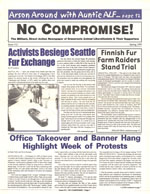
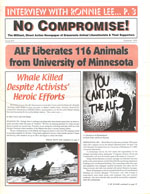
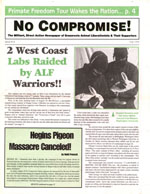
-
Periodicals
When the Nationals Were Radical, Part 1
03.08.12 | PermalinkPeTA News, Various issues (1985-1990. Washington, D.C.)
“Why Property Damage? ALF action goes beyond acts of protest. Animals will always be rescued where possible, but the main purpose of the action is often economic sabotage. Property and “things” hold no sacred value-the opposite, in fact, if they are used to cause pain and death. To STOP the very real violence of torture and killing, inanimate objects must be rendered unusable. When equipment is broken, work cannot go on as usual with a new batch of victims, insurance rates go up and so do security costs, making the enterprise less profitable.” PeTA News, Volume 2 #1
“When questioned on Irish television about an action against a butcher shop, Morrissey, an avid vegetarian, was asked “What about the safety of the butchers?” Responded Morrissey, “When you think of the horror experienced by millions of animals in slaughterhouses each year, what’s a few butchers?” His song Meat Is Murder topped the charts in 1985.” PeTA News Volume 3 #1
Imagine for a moment that a young animal rights activist with very little knowledge of the movement’s history finds a time machine and heads back into the early 1980s. Upon arrival they decide to get involved with a militant group and begin asking who they should join. At every turn they are told that PETA is the most militant group in the United States. This seems absurd to our young activist! “All PETA does is embarrass the movement with offensive ad campaigns and nudity! They are celebrity driven and devoid of substance, they kill healthy feral cats and don’t even have a rights based philosophy! They even demoted an employee for publicly supporting politically motivated arson!” Angered, our imaginary friend stomps into the DC area offices of the group to re-write history, and is shocked with what they find…
People for the Ethical Treatment of Animals experienced a meteoric rise in membership and notoriety in the early 1980’s as a direct result of their support for (and participation in) illegal direct action. Their relationship with the Animal Liberation Front was symbiotic: PETA provided the ALF with whistlebower information, credible spokespeople, and sympathetic coverage of raids. In return, PETA was placed in the media spotlight and received undercover footage and documents from the ALF that were often parlayed into high profile (and lucrative) campaigns. The atmosphere of popular militancy was exciting, and after years of slow progress people felt that supporting PETA meant backing a faster, more direct path to rights for non-humans.
PETA sold ALF support merchandise in their newsletters, ran a legal defense fund for people accused of unlawful activism, and helped popularize the concept of mischief in defense of animals. For example, PETA News sold squirt bottles of red permanent fabric ink alongside the warning that since the damage done to furs would be permanent, you should only spray the ink on your own furs! Articles talked about a likely apocryphal 15 year old who got grounded for passing out “Throw a Brick Through McDonald’s Day” pamphlets, and later chuckled as he got caught with paint bombs under his bed. Incidentally, the same article described how young “Kevin” made the paint bombs. These examples only just barely scratch the surface of the early militancy of Alex Pacheco and Ingrid Newkirk’s fledgling organization.
The story of animal rights in the United States can not be told without a thorough examination of the early days of PETA, an era sure to shock newcomers. In the coming months we will begin a more in depth analysis of their early days, but in the meantime jump into the TALON time machine and prepare to have your mind blown by these early issues of PeTA News.

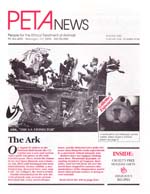







-
Periodicals, Underground
Underground #17
12.24.11 | PermalinkUnderground #17 (The rare ACTUAL final issue!) (2002, WIllowdale, ONT, Canada.)
Several months ago we posted Underground #16 along with the all caps tagline, “THE RARE FINAL ISSUE!” Boy, is our face red. The final issue of Underground is actually issue 17.
Much of what was said in our post about issue 16 is also true of 17- the news was late, the supporters groups was constantly dealing with the problems of rotating volunteers, and as print media was being challenged by the internet, Underground also seemed to be declining in quality. The final issue did contain some important bits of forgotten history though, like the joint resignation letter from ELF press officers Craig Rosebraugh and Leslie James Pickering, or the tiny article about Belgian animal liberation super-arsonist Geert Waegemans additional charges. There is also a wonderful transcription of Mirha-Soleil Ross’ radio interview with Rod Coronado, former ALF Press Officer (and current snitch apologist) David Barbarash’s 2001 Year End Direct Action Report, and a reprinting of the ever popular “Staying Free By Shutting the Fuck Up!”
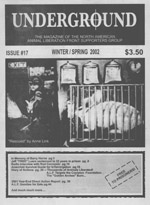
…
-
No Compromise, Periodicals
No Compromise #9, 10, 11
11.15.11 | PermalinkNo Compromise #9, 10, 11 (1998, Caldwell, NJ.)
After the shakeup caused by Freeman Wicklund’s departure, one might have expected No Compromise to slow it’s publishing schedule while it re-grouped. Instead, they had one of their most productive years, reporting on everything from the first daylight raid in the US, to the murder of Earth First! activist David “Gypsy” Chain. The volume of important articles in these issues is too great to summarize in a tiny blog post, so instead we would just like to encourage you to read each edition thoroughly. Truly, this is one of our favorite posts on Conflict Gypsy so far as it highlights so many significant events in the movement at the end of the 1990s.
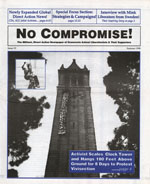
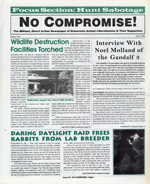

…
-
Books, Most Popular
The Black Cat Sabotage Handbook
10.31.11 | PermalinkThe Black Cat Sabotage Handbook, 3rd edition (1996, Eugene, OR.)
When I was a kid the world didn’t have the sort of instant gratification now expected for all transactions, and thank goodness. You can really appreciate the value of something more once you’ve clipped five proof of purchases, put them into an envelope, mailed them away, and waited 6 to 8 weeks for your Zartan action figure to arrive. Distribution for the Black Cat Sabotage book worked the same way – you clipped an ad out of a zine and mailed it in along with concealed cash. A few months later a copy showed up in a nondescript envelope. I still remember when mine was delivered…
My first copy of Black Cat left me feeling like I was involved in some sort of conspiracy just turning the pages. Sure, most of it was reprints that I had already seen before, but the layout, the graphics, and the text all seemed to carry the message that action was urgent and that the enemy was watching. (Of course, we were all sending envelopes with our return addresses to the same damn PO Box in Eugene, so if anyone was watching they already knew who we were!) At the time I didn’t know who was publishing or distributing it, but rumors eventually surfaced in the mid 2000’s that the book was compiled by Bill Rogers, an accused Earth Liberation Front member who took his own life behind bars in 2005. In his suicide note he said that his death was a “Jail break,” and as he slowly suffocated himself with a plastic bag he gripped one hand into a fist, and with the other, extended his middle finger.
I only met Bill one or two times and did not get to know him well, but since his death I have heard many complicated things about him. From what I gather he was at times heroic, but had some serious, perhaps unforgivable flaws that should not be ignored. In that respect he is like the book that he was rumored to have clipped together and sent out anonymously. The Black Cat Sabotage Handbook contains some good bits of information, some serious inspiration, and some decent arguments for the use of sabotage and even violence. Likewise, it also contains some foolhardy nonsense that could get someone jailed or killed for little positive gain. The cover shouts, “BEWARE!” and smart readers will heed that advice.
In closing, here is to Bill. He was a man I can best respect by keeping off a pedestal. I can not deny that many of the stories about him are disconcerting, but I also can not deny the beauty of his attempts to spark a revolution against industrialism. As his friends sat shivering and complaining in a car, it was Bill who trekked alone through snow, uphill and burdened with the weight of gallons of fuel to set a fire that would announce to millions the existence of the Earth Liberation Front. That speaks volumes about his fighting spirit, and his wild drive to right the wrongs our species has perpetrated. His death saddens me, but something tells me that someone so intent on freeing others would not have done well spending decades behind bars- perhaps in that sense his “jail break” really was a form of escape. He will be remembered as a warrior.
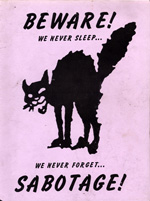
…
-
No Compromise, Periodicals
No Compromise #6-7
08.23.11 | PermalinkNo Compromise #6-7 (1997. Minneapolis, MN.)
The second year of No Compromise was packed with inspiring coverage of the growth of the militant grassroots, including some of the most important events of the 90s: Tony Wong’s hunger strike, the mass arrests and police riot at the Yerkes primate center, and the World Week for Animals in Laboratories arrests at the UC Davis primate center.
Tony Wong was only 16 years old when he was convicted for a civil disobedience action at the Lazurus department store. He immediately began a hungerstrike in prison, and after a month of not eating the staff at the juvenile facility where he was being held began force feeding him animal products through a tube forcefully inserted through his nose. The brutality faced by Tony acted as a lightning rod, and soon large demonstrations and acts of sabotage rippled across the country. The most important thing that Tony did though was to set an example of dedication that others could admire and aspire to in their own lives. Sadly, Tony eventually embraced a deeply speciesist political transformation and began consuming animals again after sacrificing so much to save them.
World Week in 1997 saw miniature police riots in Georgia and California. The protests themselves were not as important as the resulting boost to the movement created by the heavy handedness of the cops. As van loads of activists traveled to these demonstrations and found themselves sharing jail cells with like minded comrades, they soon formed tighter networks which led to greater revolutionary potential. The west coast and east coast both saw an upswing in regional actions after these arrests.
No Compromise was plagued by it’s usual production and distribution delays this year. It only got two issues finished, and they didn’t make it into people’s hands on the advertised cover dates, but both of these issues are wonderful documents of their era.
No Compromise #1-5 can be found here.
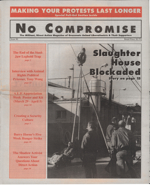
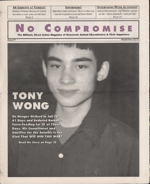
…
-
Bite Back, Periodicals
Bite Back #6-10
08.04.11 | PermalinkBite Back #6-10 (2004 – 2006. West Palm Beach, Florida.)
Our continuing posting of Bite Back Magazine carries on with this new introduction by Bite Back editor Nick Atwood:
“Issues 6-10 of Bite Back magazine were published between July 2004 and February 2006. It was a busy couple of years, for the animal rights movement and for the magazine.
Issue #8 was the first of Bite Back’s expanded format. The magazine jumped from 16 to 36 pages, and added full-color covers. Also beginning with #8, the magazine was no longer mailed out free-of-charge. The growth of the mailing list forced Bite Back to begin charging for the magazine.
In issue #7, Bite Back marked the return of the lab raid to the USA, when 401 animals were liberated from the University of Iowa. #8 features a “How It Was Done” story of the rescue of a dog from a laboratory in Tokyo, the first and so-far only such action in Japan. Issue #10 celebrated the closure of the infamous Newchurch guinea pig farm.
There’s other good stuff in these issues: interviews with Keith Mann and Mel Broughton, Bite Back’s “Top Ten List” of ALF arsons (issue #7), and popular features such as “When Animals Bite Back,” which was a collection of news reports of hunting accidents, bulls goring matadors, farmers eaten by pigs, etc. — examples of “violence” that all activists could get on board with!
But it was not all fun and liberations. Issues 6-10 include the prison addresses of some 20 different activists around the world, and the five issues were bookends to the SHAC7 criminal case– from indictment in May 2004 to conviction in March 2006.”
We hope you enjoy the magazines. (Hard copies of issues 7 and 8 are still available from Bite Back for $2 each.)





…
-
Periodicals, Underground
Underground #10-13
06.19.11 | PermalinkUnderground 10-13 (1998 Ontario, Canada)
Our Underground collection continues its way into 1998, a somewhat bittersweet year for the movement. After a period of steady growth in both illegal direct action and militant grassroots activity, No Compromise editor and well known activist Freeman Wicklund denounced the ALF (and most forms of protest) at a large demonstration in southern California. His “new” perspective was merely a recycled, pro-animal form of pacifist strategy taken from Gene Sharpe, and he demanded that people take sides. Freeman was charismatic and many young people had first began their involvement after hearing him speak. They were now torn by his change of heart. Many people dropped out, and above ground pressure campaigns largely ground to a halt.
’98 also saw a continuation of the previous years snitching epidemic, but, as always, some positive developments buoyed our spirits and resolve. In Oregon, protestors jumped the fences at a farm which bred rabbits for vivisection, and soon the United States had it’s first daylight raid underway. Katie Fedor, an organizer with Minnesota’s Student Organization for Animal Rights, became the United States’ first ALF Press Officer in more than a decade, and soon she was speaking out in favor of sabotage and liberations in major media outlets on a regular basis. The conviction of the “GandALF 3” was suddenly overturned on grounds that they had not, in fact, conspired with person unknown to carry out unknown actions at unknown locations! Finally, good people with dedication and resolve rained hell down on animal abusers all year long, resulting in thousands of lives lived outside of cages. It’s hard to keep a good movement down.
Also see Underground 1-3 and Underground 4-6 and Underground 7-9 and Underground 14-15 and the final rare issue, Underground 16.
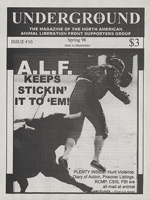


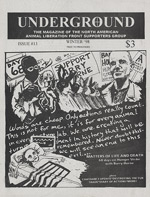
…
» Next Entries
